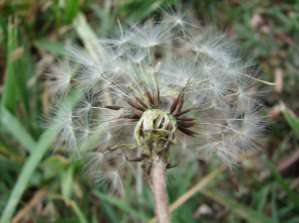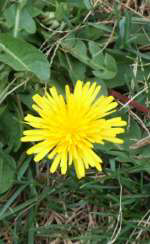 Dandelion
Dandelion
(Taraxacum officinale Web.)
|
Classification |
| Kingdom: |
Plantae |
| Division: |
Magnoliophyta |
| Class: |
Magnoliopsida |
| Order: |
Asterales |
| Family: |
Asteraceae |
| Genus: |
Taraxacum |
| Species: |
T. officinale |
 Characteristics: The Dandelion has leaves that are 5 to 25 inches long and are simple and basal. The leaves can be either entire or lobed. The leaves form a rosette above the central taproot. A bright yellow flower head (which is open in the daytime but closes at night) is borne singly on a hollow stem which rises 1.5 to 11 inches above the leaves and exudes a milky sap when broken. One rosette may produce several flowering stems at a time. The flower head is 1 to 2 inches in diameter and consists entirely of ray florets. The inner bracts are erect until the seeds mature, then flex down to allow the seeds to disperse. As the leaves grow outward they kill the surrounding vegetation by cutting off the sunlight. The dandelion flower matures into a globe of fine filaments that are distributed by wind.
Characteristics: The Dandelion has leaves that are 5 to 25 inches long and are simple and basal. The leaves can be either entire or lobed. The leaves form a rosette above the central taproot. A bright yellow flower head (which is open in the daytime but closes at night) is borne singly on a hollow stem which rises 1.5 to 11 inches above the leaves and exudes a milky sap when broken. One rosette may produce several flowering stems at a time. The flower head is 1 to 2 inches in diameter and consists entirely of ray florets. The inner bracts are erect until the seeds mature, then flex down to allow the seeds to disperse. As the leaves grow outward they kill the surrounding vegetation by cutting off the sunlight. The dandelion flower matures into a globe of fine filaments that are distributed by wind.
Habitat: Dandelions grow in open, sunny locations, such as lawns, fields, and roadsides.
Range: Native to temperate areas of North America, they have become established throughout the Americas, Australia, and New Zealand as weeds.
Native American Uses: The dandelion was used as a dermatological aid, as well as to treat gastrointestinal and throat ailments. In addition, infusions were used for food, as a blood medicine, an analgesic, and a sedative. Finally, it was used as a laxative. The Cherokee, Delaware, Iroquois, and Rappahannock Indians are among the Native American tribes known to have utilized this species.
Colonial Uses: In colonial England, the citizens used decoctions to treat ulcers, jaundice, and ailments of the liver, gall bladder, and spleen.
Modern Uses: Today, dandelions are grown commercially at a small scale as a leaf vegetable. Typically, the young leaves and unopened buds are eaten raw in salads, while older leaves are cooked. The leaves are high in vitamin A, vitamin C, and iron, carrying more iron and calcium than spinach. Ground roasted dandelion root can be used as a coffee substitute, which consumed before a meal is believed to stimulate digestive function. Dandelion root is a registered drug in Canada, sold as a diuretic. A leaf decoction can be consumed for the treatment of anemia, jaundice, and also for nervousness. The milky latex has been used as a mosquito repellent; the milk is also applied to warts, helping get rid of them without damaging the surrounding skin. This plant also is useful in farming, because its deep, strong roots break up hardpan. Dandelion contains luteolin, which has demonstrated antioxidant properties.